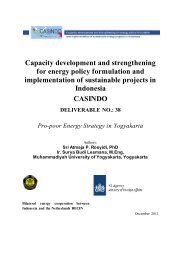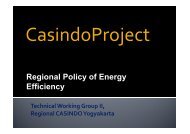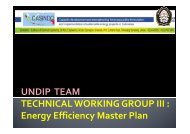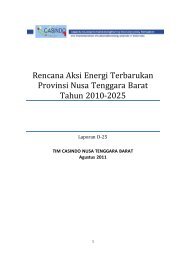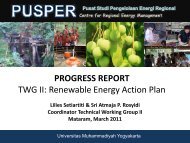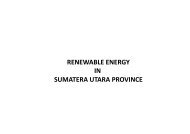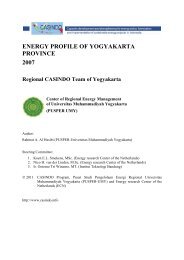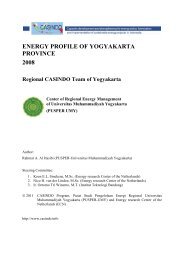Yogyakarta - Casindo
Yogyakarta - Casindo
Yogyakarta - Casindo
Create successful ePaper yourself
Turn your PDF publications into a flip-book with our unique Google optimized e-Paper software.
Identification of Energy Needs Assessment for<br />
Pro-poor Community<br />
A Lesson Learned from WP2 CAREPI program<br />
Technical Working Group (TWG) V Meeting<br />
Hotel Sultan, Jakarta December 03 rd 2009<br />
Universitas Muhammadiyah <strong>Yogyakarta</strong><br />
WP2 CAREPI IMPLEMENTATION<br />
TARGET: IDENTIFICATION OF ENERGY-RELATED NEEDS<br />
AND PRIORITIES OF POOR COMMUNITIES, KECAMATAN<br />
KARANGMOJO, YOGYAKARTA
Methodology<br />
Why used “PRA” <br />
• Participatory Rural Appraisal (PRA) methods<br />
are now well developed in relation to needs<br />
and policy assessment.<br />
• Base on PRA strategy, the communities can<br />
develop the self-assessment system and build<br />
the simple mechanism for evaluating their<br />
energy needs.<br />
• The mechanism provides the communities<br />
which are able to develop some alternative<br />
local energy potentials in adjacent their village.<br />
• PRA can be one of tools to provide the<br />
community for running sustainable<br />
development particularly in this energy<br />
program.
• HOUSEHOLD<br />
– To get a better insight in current energy related problems.<br />
– To calculate the energy need and its consumption (cost) for energy.<br />
– To evaluate the energy priorities for households.<br />
– To formulate the available energy potentials surrounding their<br />
village(s).<br />
• LOCAL ENTREPRENEURS<br />
– To get a better insight in current energy related problems.<br />
– To calculate the energy need and its consumption (cost) for energy.<br />
– To formulate the energy potentials surrounding their village(s).<br />
– To evaluate the priority of energy use in ranking according to the<br />
urgency of a problem for local entrepreneurs.<br />
– To identify possible economic activities (development) that can be<br />
operated if the new energy have been supplied to the sites.<br />
An overview of existing data/study/research/policy in<br />
relationship with pro-poor Local Economic<br />
Development (LED)<br />
• This stage is a pre-survey which was conducted in<br />
order to gather information for choosing some<br />
alternative locations for needs assessment work<br />
programme. The intensive discussions with regional<br />
energy office of Dinas Pertambangan Kabupaten<br />
Gunungkidul and BPS (Biro Pusat Statistik, Statistical<br />
Centre Bureau) of Kabupaten Gunungkidul were<br />
carried out.<br />
• The outcome of this discussion is to give the global<br />
description regarding to view of region, economical<br />
aspect and current energy policies/programmes which<br />
have been implemented in the region/kabupaten.
Survey on Participatory Rural Appraisal (PRA) for<br />
Initial Data Collection<br />
• The survey was employed by visiting the local stakeholder, regional office (Dinas)<br />
of energy and the local entrepreneur for gathering the information related to the<br />
real situation of cultural and social condition of community.<br />
• The information were collected during the survey (semi-structured interview)<br />
based on the following issues for set of guideline questions.<br />
– Average daily or monthly income of rural communities in Kecamatan<br />
Karangmojo,<br />
– Form of energy which is currently used for domestic activities, community<br />
services and local entrepreneur in Kecamatan Karangmojo,<br />
– Renewable energy potentials and sources are available locally in Kecamatan<br />
Karangmojo,<br />
– The lifestyle, community social characteristics and cultural background in<br />
Kecamatan Karangmojo (in order to implement the PRA activities<br />
successfully),<br />
Outcomes from 1 st Workshop<br />
• Semi-structured interview and focus group discussion are<br />
methods of qualitative participatory research method which<br />
was used in the PRA approach for energy needs assessment.<br />
• The main issues delivered in this activity was: (1) current<br />
energy consumption, (2) energy related needs and problems;<br />
and (3) energy priorities in rural community of Kecamatan<br />
Karangmojo.<br />
• Based on these issues, some short-presentations for the<br />
workshop were written and a set of guideline questions were<br />
designed for the semi-structured interview activities.<br />
• Thus, FDG materials were also designed for group discussion in<br />
the programme.
Outcomes from 2 nd Workshop<br />
• The main issues discussed in this activity was:<br />
– energy priorities and programs for community and<br />
business opportunities in the village: summary from the<br />
PRA and 1st workshop;<br />
– formulation on regional energy policy on selected<br />
community and local entrepreneurs in Karangmojo.<br />
– propose several alternative energy programmes.<br />
Description of<br />
Selected Area<br />
• Karangmojo capital city is<br />
Gedangrejo.<br />
Karangmojo
Geography Information<br />
• Attitude: 105 m SWL<br />
• Rainfall intensity: 3.100 mm/year<br />
• Topography : flat and hilly area<br />
• Location: 10 km from Kabupaten Gunungkidul,<br />
and 70 km from Kota <strong>Yogyakarta</strong><br />
• Area: 80.12 km 2 , dominated by not-rice farming<br />
(palawija/plants, fruits) i.e. dry field (not<br />
agriculture used) and national forest, and others<br />
is rice farming (rainfall system), and sultan<br />
ground.<br />
No.<br />
Demography<br />
Population<br />
VILLAGE<br />
MALE FEMALE TOTAL<br />
1 Bendungan 981 1,131 2,112<br />
2 Wiladeg 1,976 2,136 4,112<br />
3 Kelor 1,394 1,421 2,815<br />
4 Ngipak 1,506 1,636 3,142<br />
5 Karangmojo 3,648 3,822 7,470<br />
6 Gedangrejo 2,647 2,801 5,448<br />
7 Ngawis 1,751 1,922 3,673<br />
8 Bejiarjo 7,721 8,049 15,770<br />
9 Jatiayu 3,785 3,687 7,472<br />
Remark: 60% of population as farming worker<br />
Growth Rate of Population: 0.15 %<br />
25,409 26,605 52,014
PLN Costumer on 2006<br />
No Village Household<br />
(Registered)<br />
PLN Costumer<br />
Ratio<br />
( % )<br />
1 Bendungan 615 318 51,7<br />
2 Bejirejo 3.899 2.377 60,96<br />
3 Wiladeg 1.262 887 70,28<br />
4 Kelor 811 449 55,36<br />
5 Ngipak 944 637 67,48<br />
6 Karangmojo 2.344 1.380 58,87<br />
7 Gedangrejo 1.602 1.010 63,04<br />
8 Ngawis 1.095 700 63,93<br />
9 Jatiayu 1.797 1.035 57,60<br />
Kecamatan Karangmojo 14.336 8.722 60,84<br />
Type of Energy Used in Kecamatan Karangmojo<br />
No<br />
Activities<br />
Type of Energy<br />
Supply<br />
Electricity Fuels Firewoods Electricity Fuels Firewoods<br />
1 Cooking - √ √ - Buy<br />
Buy and<br />
Collect<br />
2 Lighting √ √ - PLN Buy -<br />
3<br />
Production (Local<br />
Entrepeneur)<br />
- √ √ - Buy<br />
4 Ironing √ - - PLN - -<br />
5 Transportation - √ - - Buy -<br />
6<br />
Water Pump for<br />
Irrigation<br />
- √ - - Buy -<br />
Buy and<br />
Collect
Energy Consumption<br />
No<br />
Jenis Energi<br />
Consumption/<br />
month<br />
Price Unit<br />
(IDR/Rp)<br />
1 Petrol 60 lt/ household Rp. 6.000/ lt<br />
2 Kerosene 10 lt/ household Rp. 3.000/ lt<br />
3 Firewoods 6 string/ household Rp.12.500/ string<br />
4 Electricity Rp. 50.000/ household Rp. 600/ kwh<br />
5 Diesel (for irrigation) 8 lt/ h/ farmer group Rp. 5.000/ lt<br />
Energy share per Month in<br />
Grid Connection Household in<br />
Karangmojo<br />
Energy share per Month in<br />
Non Grid Connection<br />
Household in Karangmojo
Renewable Energy Resources in Gunungkidul<br />
No Type of Energy Source Potential Energy<br />
1 Wind --- 2.5 kw<br />
2 Solar photovoltaic --- 3 kwh/m 2 /day<br />
3 Bioethanol (Cassava) Cassava plantation 48,007.67 kwt<br />
4 Biomass (sampah hutan)<br />
Agricultural/forest<br />
waste/residues<br />
764.17 ha<br />
5 Biogas Livestock 8,199 cows<br />
6 Biodiesel<br />
”Jarak” or Jatropha (physic<br />
nuts)<br />
4,282.2 ha<br />
Sources: Depth Interview, FGD in Energy, PUSPER UMY<br />
Biogas Energy Programme Package for cooking<br />
-Building Biogass Instalation Prototype<br />
-Mentoring and Community Development<br />
-Involving the Financial Institution for Financing<br />
-Study in Waste Management
Package of Biogass Energy Program for Home<br />
Industries<br />
Small Local Entrepreneur (Tahu and Tempe<br />
Industry)<br />
Biogas Usage for Alternative Energy Solutions<br />
2,5m<br />
2,1m<br />
0,4m<br />
2,1m<br />
Picture : Fixed-dome Biogas
Construction Cost for Biogas Reactor<br />
No Material/Component Size Required Unit Price<br />
1 Cement 40 kg per<br />
unit<br />
2 Foundation Materials<br />
(Stone)<br />
Amount<br />
(IDR)<br />
48 per unit 41,000 1,968,000<br />
- 6 m 3 /unit 300,000 1,800,000<br />
3 Sand - 13 m 3 /unit 400,000 800,000<br />
4 Clay-Brick<br />
(batu bata merah)<br />
5:20:10 3,500 units 450 1,575,000<br />
5 PVC-Pipe 8 inch 1 unit 400,000 400,000<br />
6 PVC-Pipe 0.5 inch 30 m 12,000/4 m 96,000<br />
7 PVC-Pipe 0.75 inch 1 unit 18,000 18,000<br />
8 Addittive Material for<br />
Mix Concrete Design<br />
(Ekosal)<br />
- 3 kg 40,000 120,000<br />
9 Workmanship 6 man 15 days 40,000/day 3,600,000<br />
Total Construction Cost 10,377,000<br />
Note : Economic life-time of biogas reactor is estimated 20-25 years<br />
Cost Flow Analysis<br />
No Remark Volume Unit Price<br />
1 Safe from kerosene<br />
used<br />
2 Safe from<br />
Firewood<br />
3 Benefit/Safe from<br />
the use of Organic<br />
Fertilizer<br />
Safe per<br />
Month<br />
Safe per Year<br />
10 liter/month Rp. 7,000 Rp. 70,000 Rp. 840,000<br />
6 sting/month Rp. 12,500 Rp. 75,000 Rp. 900,000<br />
20 kg/day Rp.500 Rp. 300,000 Rp. 3,600,000<br />
Benefit for the use of biogas digester per year Rp. 5,340,000<br />
Construction cost of giogas digester (Table 5.1) Rp. 10,377,000<br />
Note : 1 cow can produce 15 kg animal waste per day. Every 12 kg of waste can be used for methane<br />
gas which converts with ½ liter of kerosene
No Remarks Investment<br />
1 Investment cost of proposed digester Rp. 10,377,000<br />
2 Stove for cooking (1 unit) Rp. 600,000<br />
Total Investment Rp. 10,977,000<br />
3 Saving in Year 1 Rp. 5,340,000<br />
4 Rest from Investment of Year 1 Rp. 5,637,000<br />
5 Saving in Year 2 Rp. 5,340,000<br />
6 Rest from Investment of Year 1 Rp. 297,000<br />
Payback Periode is 2 years + (Rp. 297.000/Rp.5.340.000 × 12 months)<br />
= 2 years 17 days<br />
Some biogas equivalents (Kristoferson and Bokalders 1991)<br />
Application<br />
Lighting<br />
Cooking<br />
Fuel replacement<br />
Shaft power<br />
Electricity generator<br />
1m 3 Biogas Equivalent<br />
Equal to 60 – 100 watt bulb for six hours<br />
Can cook three meals for a family of a five or six<br />
0.7 kg of petrol<br />
Can run a one horsepower motor for two hours<br />
Can generate 1.25 kilowatt hours of electricity
Biodiesel Energy Package for Irrigation<br />
- Study for Production and Efficiency of<br />
Biodiesel from the Jathropa Curcas Oil<br />
- Mentoring Financing Skim<br />
Program for the people<br />
Stove for Jatropha Oil<br />
No Remark Specification<br />
1 Dimension 28 x 28 x 27 cm<br />
2 Tank capacity 2 liter<br />
3 Fire flame Blue with red<br />
4 Fuel consumption 225 ml/hour<br />
5 Water boiling 14 minutes/2 liter<br />
No Remark Volume Price Unit<br />
Estimated<br />
Cost<br />
1 Roller/Presser Equipment<br />
for Jatropha Oil<br />
1 unit Rp. 2,000,000 Rp. 2,000,000<br />
2 Jatropha cultivation<br />
- Land 0.2 ha - -<br />
- Seed 0.4 kg Rp. 50,000 Rp. 20,000<br />
3 Wick Stove 1 unit Rp. 200,000 Rp. 200,000<br />
Investment Total/Cost Rp. 2,220,000<br />
Note : 1 liter Jatropha oil needs 3 kg of Jatropha seeds. 1 ha land can produce 15 kg of seed<br />
per day with seeds for plantation of 2 kg. Land is used for the programme is a marginal land<br />
that does not cultivated by agricultural plants for food or commercial purposes.
The economic benefit and safe analysis for a household<br />
Estimated Cost<br />
No Remark Volume Price Unit<br />
(per year)<br />
1 Kerosene Stove 1 unit Rp. 200,000 Rp. 200,000<br />
2 Minyak Tanah 10 liter/month Rp. 7,000 Rp. 840,000<br />
3 Firewood 6 string/month Rp. 12,500 Rp. 900,000<br />
Cost for cooking using kerosene and firewood Rp. 1,940,000<br />
Cost for cooking using Jatropha oil stove and investment for Jatropha<br />
pressing machine<br />
Deficits per household at first year of Jatropha oil programme (fourth<br />
year of programme)<br />
Rp. 2,220,000<br />
Rp. - (280,000)<br />
Saving per household per year after using the Jatropha oil Rp. 1,740,000<br />
Based on the net cash-flow in the cash-flow analysis, it indicates household can receive<br />
the saving from Jatropha oil for cooking programme started from the fifth year of<br />
implemented programme.<br />
Year<br />
1<br />
2<br />
3<br />
4<br />
5<br />
6<br />
7<br />
8<br />
Investment<br />
Stove and<br />
Pressing<br />
Machine<br />
Operational<br />
Cost<br />
Discount<br />
Factor<br />
14%/pa<br />
PV<br />
Operational<br />
Cost<br />
Cash in-flow<br />
PV<br />
Cash in<br />
Flow<br />
Net Cashflow<br />
0 40,000 0.8772 35,088 0 0 -35,088<br />
0 20,000 0.7695 15,389 0 0 -15,389<br />
0 20,000 0.6750 13,499 0 0 -13,499<br />
2,000,000 20,000 0.5921 1,196,002 1,660,000 971,012 -224,991<br />
0 20,000 0.5194 10,387 1,740,000 893,314 882,927<br />
0 20,000 0.4556 9,112 1,740,000 783,609 774,497<br />
0 20,000 0.3996 7,993 1,740,000 687,376 679,383<br />
0 20,000 0.3506 7,011 1,740,000 602,962 595,950
Feasibility Analysis on Jatropha Oil for Water Pump System in<br />
Kecamatan Karangmojo (Analysis for 1 Farmer Group)<br />
No Remark Volume Price Unit<br />
Estimated Cost<br />
(per year)<br />
1 Generator (Diesel Fuel) 1 unit Rp. 1,000,000 Rp.1,000,000<br />
2 The need of diesel fuel for irrigation 12 liter/day Rp. 6,000 Rp. 17,280,000<br />
(calculated for dry session on 8<br />
months/year)<br />
3 Generator (Jatropha Oil) 1 unit Rp. 1,500,000 Rp. 1,500,000<br />
4 Jatropha cultivation:<br />
- Landuse for cultivation<br />
- Jatropha seeds<br />
- Estimated cultivation cost<br />
5 Crushing and Pressing Machine for<br />
Jatropha seed<br />
2.4 ha<br />
4.8 kg/year<br />
2.4 ha/year<br />
Rp.2,500,000<br />
Rp. 50,000<br />
Rp.1,400,000<br />
Rp. 6,000,000<br />
Rp. 240,000<br />
Rp. 3,360,000<br />
1 unit Rp. 4,000,000 Rp. 4,000,000<br />
Total cost per year for Diesel Generator (1 + 2) Rp. 17,280,000<br />
Total cost per year for Jatropha Generator (3 + 4 + 5) Rp. 13,600,000<br />
Saving (first year) after Jatropha harvest and first Jatropha oil production Rp. 3,680,000<br />
Saving per year after first year Rp. 7,680,000<br />
Note : a. Capacity of Pressing machine, Input: 100 kg/day, Production capacity: 20% × 100 kg Jatropha seeds or 25<br />
liter JO/day. Lifetime of machine is about 10 years<br />
b. The effective raining session in Kecamatan Karangmojo is estimated for 4 months.<br />
c. Jatropha cultivation is about 3 years for harvest and can be produced to be Jatropha oil (JO).<br />
Year<br />
1<br />
2<br />
3<br />
4<br />
5<br />
6<br />
7<br />
8<br />
9<br />
10<br />
11<br />
12<br />
13<br />
Investment<br />
for JO<br />
Machine<br />
Operational<br />
Cost<br />
Discount<br />
Factor<br />
14%/pa<br />
PV<br />
Operational<br />
cost<br />
Cash in-flow<br />
PV<br />
Cash in<br />
Flow<br />
Net Cash-flow<br />
0 9,600,000 -8,421,053 8,421,053 0 0 -8,421,053<br />
0 9,600,000 -16,842,105 7,386,888 0 0 -7,386,888<br />
0 9,600,000 -25,263,158 6,479,727 0 0 -6,479,727<br />
4,000,000 9,600,000 84,506,002 5,683,971 17,280,000 10,231,147 4,547,177<br />
0 9,600,000 142,566,944 4,985,939 17,280,000 8,974,691 3,988,751<br />
0 9,600,000 215,401,662 4,373,631 17,280,000 7,872,536 3,498,905<br />
0 9,600,000 303,010,157 3,836,518 17,280,000 6,905,733 3,069,215<br />
0 9,600,000 405,392,428 3,365,367 17,280,000 6,057,660 2,692,294<br />
0 9,600,000 522,548,477 2,952,076 17,280,000 5,313,737 2,361,661<br />
0 9,600,000 654,478,301 2,589,541 17,280,000 4,661,173 2,071,632<br />
0 9,600,000 74,105,263 2,271,527 17,280,000 4,088,748 1,817,221<br />
0 9,600,000 962,659,280 1,992,567 17,280,000 3,586,621 1,594,054<br />
0 9,600,000 1,138,910,434 1,747,866 17,280,000 3,146,159 1,398,293<br />
14 0 9,600,000 1,329,935,365 1,533,216 17,280,000 2,759,789 1,226,573<br />
Total 4,000,000 134,400,000 5,782,987,996 57,619,886 190,080,000 63,597,994 55,176,942
FGD:<br />
Stakeholders<br />
Analysis<br />
NO STAKEHOLDERS CONTRIBUTIONS<br />
1 Community, farmer groups and<br />
local entrepreneurs<br />
2 Local administration<br />
office/government<br />
3 Regional Mining and Energy<br />
Office of Gunungkidul Regency<br />
Owner and take responsibility for managing the installed energy<br />
infrastructure in Kecamatan Karangmojo<br />
1. Provide an energy facilities and infrastructure<br />
2. Budget allocation from Village Budget/Anggaran Dana<br />
Desa (ADD) for development of energy alternative at each<br />
region.<br />
3. Supervising the implementation of the proposed energy<br />
project.<br />
Continue and focused on programs in next fiscal period<br />
(APBD/APBN) related with energy alternative development in<br />
region includes infrastructure provision and capacity building.<br />
4 Banking, Micro Finance<br />
Institution, Usaha Kecil and<br />
Menengah (UKM), Koperasi<br />
(Cooperation/Economic<br />
Enterprise)<br />
1. Commitment to provide Kredit Usaha Rakyat (KUR) and<br />
other scheme of credits for farmers in building an energy<br />
infrastructure.<br />
2. Capacity building for famer groups especially in finance<br />
management aspect.<br />
3. Possible to be one of investors for energy infrastructure<br />
development.<br />
5 University 1. Provide training and education facilities for capacity<br />
building in development of energy alternative.<br />
2. Mentoring and assisting in operational of energy<br />
alternative.<br />
3. Improving an applied research and development of energy<br />
alternative.<br />
FINANCING SCHEME FOR THE PROPOSED<br />
PROGRAMMES<br />
These schemes involve all financial stakeholders, i.e. Banking,<br />
Micro Finance Institution, Usaha Kecil dan Menengah (UKM),<br />
Cooperation and Regional Energy Office, as follows:<br />
1) Subsidies Scheme<br />
2) Credit Scheme<br />
3) Combination of Various Funding Resources
Proposed Strategies for CASINDO TWG V in<br />
<strong>Yogyakarta</strong> Region<br />
• The program will be in-line with community economic development<br />
program.<br />
• PRA approach will be used in collaboration with government officer<br />
& student community services for assisting and empowering the<br />
community.<br />
• Three techniques will be implemented in PRA, i.e. in-depth direct<br />
interview, focus group discussion and community based activities.<br />
• Several workshops between community, local entrepreneurs,<br />
regional government offices, universities and (micro) financial<br />
institutions will be conducted for connecting the energy problems,<br />
potential, policy and program implementation.
Next Stages<br />
• Evaluation the existing data of poor<br />
community and potential energy sources<br />
nearby.<br />
• Identify the new alternative locations for<br />
CASINDO.<br />
• Depth-discussion with Dinas related the<br />
programmes.<br />
ENERGY FOR PROVERTY ALLEVIATION



